Article from the series “Calendar of work for gardeners and vegetable gardeners”
January and February are usually the coldest months of the year. Helping the garden to safely endure the hardships of winter is the main task of the gardener in the middle of winter.
During the long January holidays, you had the opportunity to visit your “pets” wintering at the dacha. There will be work in the garden in January.
What work should be done in the garden in January
The roots of trees and shrubs need special care. Trees tolerate even a winter with little snow better if they received moisture-recharging irrigation in the fall, if the soil around them met the winter in a loose state and under a reliable layer of mulch.
Trees on compacted and insufficiently moist soil are at risk of drying out their tissues under the influence of winds and frosts.
Winter drying often affects shoots of berry bushes, especially raspberries and gooseberries, that are damaged by diseases and whose growth is delayed in the fall. Mulch the frozen soil around the berry plants, as well as woody cuttings planted in the fall, with humus, compost or peat to protect the suction roots, which die already at minus 2-5 degrees.
The best protection for roots from frost is snow. If there is not enough of it, rake it from paths, from ditches and scatter it under bushes, under young trees.
After a snowfall, it is useful to cover not only the tree trunk with snow, but also the tree trunk.
But a large amount of heavy wet snow or an ice crust on the branches can harm the plants. To prevent breaks, shake off snow from the branches or prop up old and weak tree branches with chatals. And tie columnar trees loosely in several places.
If possible, trample down the snow several times during the winter: the plants will be warmer, and mice will not be able to get to the trunks of young trees. Cover strawberry bushes with snow, retain the snow with brushwood, shields, and plant debris.
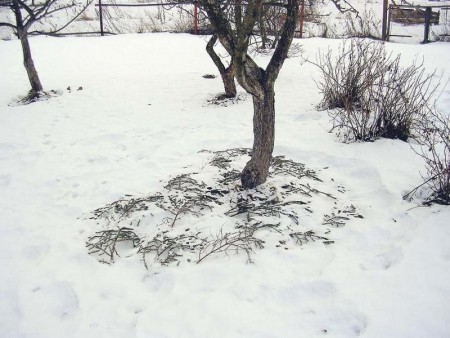
There is enough work at the dacha even in January: we need to cover the trees with snow and protect them from rodents.
If you haven’t done this before, then in January it’s not too late to do this work - walk through the garden, carefully examine the exposed crowns.If you notice diseased (mummified) fruits on the branches that spread disease, cut them off and burn them in the fire. Send cut nests of hawthorn, goldentail and other pests there.
In January it’s already worth taking care of the trunks of fruit trees. With sharp fluctuations in day and night temperatures, the bark may burst and frost holes may occur. You can find them by knocking on the trunk with a piece of wood: in those places where the bark has come off, the sound will be dull.
On a warm sunny day, you need to carefully clean it, apply a tight gauze bandage and cover the entire area with melted garden varnish. When it dries, wrap the trunk in burlap, cover the top with film and leave until spring.
Check out the autumn whitewash. If it peels off, restore it during the thaw.
If the trunks were not whitened in the fall, do this work now: rake away the snow, whiten and hill up the trees again. It may be too late in February.
January work in the fruit storage
In the storage area with fruits, monitor the air temperature and humidity. Take measures in a timely manner: when it gets cold (severe frost is predicted), close the hatch and vents; when it gets warm, open it. Fruits freeze already at minus 1.4-1.8 degrees.
When the temperature rises, the fruits become overripe; when they become too dry, they wilt. Excessive moisture leads to rotting of the fruits and the appearance of an unpleasant aftertaste.
For most apple varieties, the optimal temperature is from 0 to 2-3 degrees and a relative air humidity of 85-90 percent. If necessary, sort through the apples and pears stored for storage. If you notice mouse gnawing on the fruits, set up mousetraps and spread out poisoned baits.
Seed stratification
At the end of January - beginning of February, cherry and plum seeds laid for stratification begin to hatch. To stop germination, place a bag of seeds in a snow pile, cover it with sawdust on top with a layer of 8-10 cm. And store until April-May.
You can stratify the seeds of fruit crops to speed up their germination.
Layer the seeds with wet sand, sawdust or peat chips and keep them at a temperature of 1-5 degrees and with free access of air.
At the end of January, the period of natural dormancy for plants ends. Therefore, make sure that the buds on the cuttings prepared for grafting do not swell. If they begin to swell, move them to a cooler place.
Winter vaccination
In January, you can begin winter (tabletop) grafting of rootstocks harvested in the fall. After finishing the work, place the grafted rootstocks in a box, the bottom of which is lined inside with film with slits for water drainage. Place a layer of sawdust on the bottom, place grafts on them, sprinkle them with sawdust, and so on until the top of the box. Cover the box with film.
Keep the box with vaccinations at a temperature of plus 20 degrees for 10 days. After a few days, untie 1-2 grafts and check if they have grown together. Tie it up, put it in a box and place it in the basement before planting it in the ground.
Some gardeners manage to plant cuttings into the crown of trees right in the garden at the end of January. And it turns out well. Give it a try. Select a branch, split it. The length of the split is 3-4 cm. Take an annual branch as a scion. Make a cut first on one side, then on the opposite. The cutting can have 6-7 or 3-4 buds.
Insert the cutting into the split, tie it with fabric folded in 4 layers (possibly with cotton wool pads).Cover everything on top with film. And wait until spring.
Preparing for the upcoming summer season
If possible, store wood ash, bird droppings, and manure in winter. When stacking manure, sprinkle it with superphosphate (2-2.5 kg per 100 kg of manure). Purchase mineral fertilizers and plant protection products in advance. Take precautions when storing them.
Every time you visit your dacha in January - February, feed the birds and make additional feeders.
Stock up on fertilizers, repair gardening equipment, and treat them with a strong solution of potassium permanganate. Buy what you're missing.
You can prepare fertilizer at home in winter. Dry potato peelings on paper near the radiator. Place them in plastic bags and take them to the country in the spring. You can put the cleaning in the compost, or you can burn it and enrich the ash with minerals.
Gardener's January concerns
January is not the busiest month for gardeners. There is still time to sit quietly and think about what and where you will plant. Check the availability of seeds and, if necessary, purchase the missing ones. Don't forget about the soil for seedlings. You need to not only buy it, but also have time to freeze it properly, and thus get rid of pests and infections that could be there.
Many vegetable growers are already starting to grow vegetable seedlings with a long growing season. These plants primarily include:
- White cabbage and cauliflower
- Hot peppers and early varieties of peppers for growing indoors.
- Early varieties of tomatoes intended for growing in greenhouses
- Leeks and nigella, if you are going to grow turnips in one summer
- Root celery
- Parsley and dill
- If you are planning to grow potatoes from seeds, it’s time to start sowing.
- When sowing garden strawberry seeds in January, the harvest can be obtained at the end of summer
Flowers that start growing in January
In January, flower sowing usually begins in two cases:
- Flower seedlings are grown as seedlings and should bloom in May.
- The florist really wants (regardless of any inconveniences and hassles) to see his favorites blooming as soon as possible.
In January, you can sow the following flowers for seedlings:
- Turkish cloves and Shabo cloves
- Eustoma
- Lobelia
- Petunia
- Garden primrose
- Pansies
- Fuchsia
- Rhodendron
- Kobeya
- Cyclomen
- Bulbs for forcing by March 8
All these flowers, when planted in January, will bloom in May June
However, all these seedlings will definitely need good lighting. Think about whether you can organize such lighting and whether you are ready for such troubles. Maybe it’s worth postponing planting to a later date?
Other articles in this series:
- Works of gardeners and vegetable gardeners in February.
- Works of gardeners and vegetable gardeners in March.
- Works of gardeners and vegetable gardeners in April.
- Works of gardeners and vegetable gardeners in May.
- Works of gardeners and vegetable gardeners in June
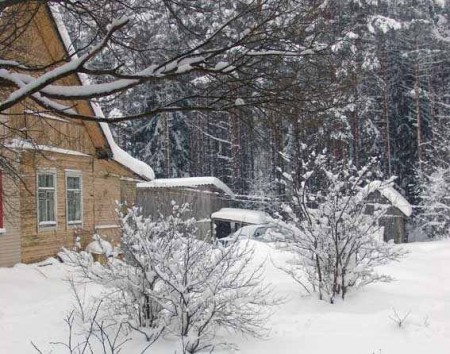
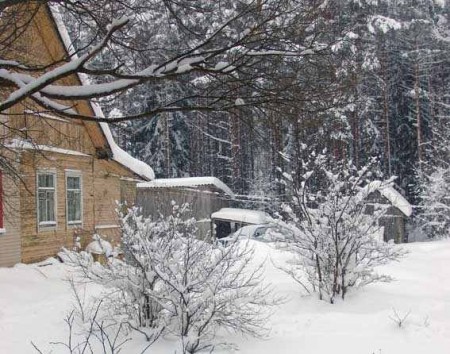
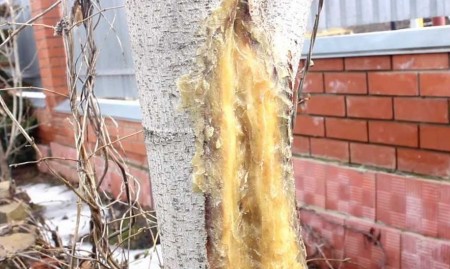
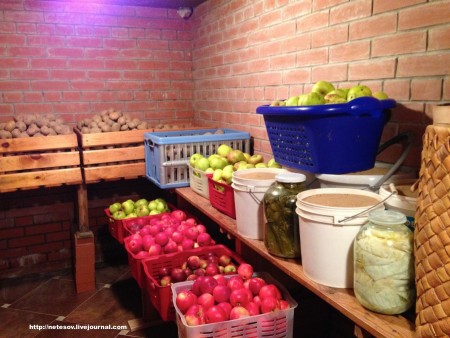
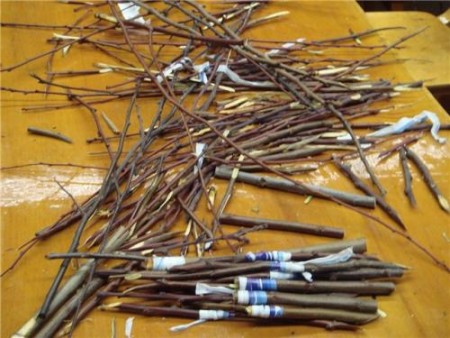

 (8 ratings, average: 4,13 out of 5)
(8 ratings, average: 4,13 out of 5) CUCUMBERS NEVER GET SICK, I'VE BEEN USING ONLY THIS FOR 40 YEARS! I SHARE A SECRET WITH YOU, CUCUMBERS ARE LIKE THE PICTURE!
CUCUMBERS NEVER GET SICK, I'VE BEEN USING ONLY THIS FOR 40 YEARS! I SHARE A SECRET WITH YOU, CUCUMBERS ARE LIKE THE PICTURE! You can dig a bucket of potatoes from each bush. Do you think these are fairy tales? Watch the video
You can dig a bucket of potatoes from each bush. Do you think these are fairy tales? Watch the video
 How our fellow gardeners work in Korea. There is a lot to learn and just fun to watch.
How our fellow gardeners work in Korea. There is a lot to learn and just fun to watch. Eye trainer. The author claims that with daily viewing, vision is restored. They don't charge money for views.
Eye trainer. The author claims that with daily viewing, vision is restored. They don't charge money for views. A 3-ingredient cake recipe in 30 minutes is better than Napoleon. Simple and very tasty.
A 3-ingredient cake recipe in 30 minutes is better than Napoleon. Simple and very tasty. Therapeutic exercises for cervical osteochondrosis. A complete set of exercises.
Therapeutic exercises for cervical osteochondrosis. A complete set of exercises. Which indoor plants match your zodiac sign?
Which indoor plants match your zodiac sign? What about them? Excursion to German dachas.
What about them? Excursion to German dachas.